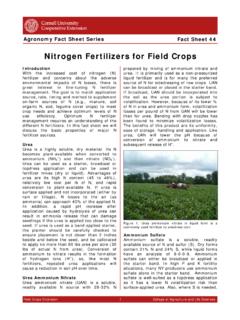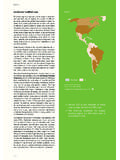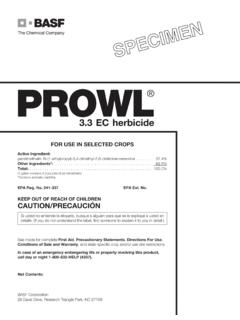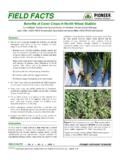Transcription of Nutrient Management of Berry Crops in Oregon
1 Nutrient Management of Berry Crops in Oregon Bernadine C. Strik Professor, Extension Berry Crops Specialist Department of Horticulture Oregon State University This summary is intended as a brief overview and as a supplement to the Nutrient Management guides available online at Oregon State University ( ): Nutrient Management for Blueberries in Oregon , EM 8918; Caneberries: Nutrient Management Guide, EM. 8903-E; and Strawberries. Fertilizer Guide, FG 14). I encourage everyone working with commercial Berry Crops to access these and other publications on soil sampling, modifying soil pH etc.
2 Key questions that need to be answered with regard to any Nutrient Management program are: How much Nutrient should be applied? When is the best time to apply the Nutrient ? What source of the Nutrient or what material is best to apply? And what method of application is best? How much Nutrient should be applied is often estimated using soil and plant tissue testing, experience, observations of plant growth, and information on the amount of Nutrient generally required for good growth and production. Nutrient availability and plant Nutrient status are assessed by soil and tissue testing.
3 I will focus most on this aspect of developing and adjusting a Nutrient Management program. Soil testing Soil testing is commonly the only method used to adjust Nutrient Management programs in annual Crops in these Crops there is not enough time to adjust fertilizer programs based on tissue analysis. In perennial Crops , soil testing is important to adjust soil Nutrient status prior to planting. This not only gets plants off to a good start, but is the only way to effectively increase soil pH. Pre-plant incorporation of nutrients that are immobile or do not move readily into the rooting zone with a surface application ( phosphorus, potassium) is very effective.
4 Prior to planting get a representative sample of the field/block. Taking soil samples to the tillage depth (where any pre-plant application of nutrients would be incorporated) is recommended. You may also choose to take a tillage depth sample ( to 6 inches deep) but also a deeper one (from 6 inches to or ft) to get an idea of stratification of soil pH and nutrients. Take soil samples well in advance of planting so that pH can be adjusted ( sample in early fall for spring planting of caneberries or strawberries or a year in advance for blueberries) it takes time for incorporated lime or sulfur to react and change soil pH.
5 Base nutrients to be incorporated prior to planting on target or recommended soil levels (Table 1). In blueberry, be conservative on addition of sulfur to acidify the soil, as raising the pH to the target range if too much sulfur (S) was incorporated is difficult. Be aware that standard fertilization programs lead to acidification of the soil in the row the pH will thus decrease over time in all perennial Berry Crops . Generally, for every 100 lb N/acre/year applied (as urea), soil pH will decrease unit per year in our soil. For these reasons the target pH for newly planted Berry Crops should be at the top of the recommended range (Table 1).
6 Bernadine Strik, Oregon State University, May 2013 version Page 1. Annual soil sampling is not needed in perennial Berry Crops unless you are correcting a problem. We recommend soil samples be collected every two to three years to monitor changes in soil Nutrient status. In established fields, sample at the same time of year ( late winter or fall) so that years can be more easily compared. Collect soil samples in the plant row (where the fertilizer is applied) and, in drip irrigated fields, sample at a similar distance from the emitter and plant in all sub-sample locations.
7 The irrigation wetting front, fertigation, and band applications of fertilizer affect soil sample results. Do not collect soil samples in spring right after fertilization has occurred. If mulch is present, remove the mulch layer before taking the soil sample. How deep should the soil sample be? You can take soil samples so that the depth reflects where the most active Berry crop roots are: soil surface to ft deep in strawberries and ft deep in caneberries and blueberries. However, nutrients and soil pH. are often stratified fertilization over time leads to varying soil pH and Nutrient content with soil depth.
8 If you take a sample from the soil surface to ft deep, the reduced soil P and K and the higher soil pH at the lower depths will reduce the average soil P and K and increase the soil pH relative to what is found in the fertilizer zone nearer the soil surface. This should be kept in mind when interpreting soil analysis results and planning Nutrient Management programs. You can take soil samples at two depths ( 0 to 3 in. and 3 in. to 1 ft) to better understand the level of stratification occurring in your farm. Testing soil to predict nitrogen (N) application rates in Berry Crops is not advised.
9 Note that high soil N. concentration in late summer/fall can be an indicator of excessive N fertilization. Table 1. Suggested critical levels for soil Nutrient content (adapted from OSU Nutrient Management guides listed in first paragraph). Nutrient Unit Blueberry Caneberry Strawberry pH (2:1; in water) target: to to to Deficient at less than: Phosphorus (P; Bray) ppm 25 to 40 20 to 40 45. Phosphorus (Olsen) ppm 10 to 20 10 to 20 20. Potassium (K) ppm 100 to 150 150 to 350 75 to 175. Calcium (Ca) ppm 1000 1000 1000. Magnesium (Mg) ppm 60 120 120. Manganese (Mn) ppm 20 to 60 20 to 60 20 to 60.
10 Boron (B) ppm to to EC dS/m 2 2 2. Note. Recommended levels may change in the future from local research findings. Keep soil pH in the range considered ideal for the Berry crop (Table 1). In blueberry, if soil pH is too low then we see problems with manganese (Mn) and aluminum (Al) toxicity to plants. When soil pH is too high we can see problems with less iron (Fe) and zinc (Zn) being available. If pH is below or above recommended levels, plant symptoms of Nutrient deficiencies or toxicities often occur; in such situations the problem is best fixed by correcting soil pH.







